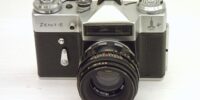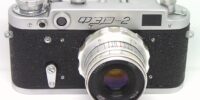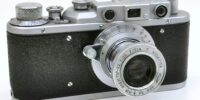Soviet Lens Mir-20M 3,5/20 review
Mir-20M 3,5/20
Extra-wide-angle lens with coated optics for SLR cameras with M42 mount.
Mir-20 was created on the basis of the Flektogon 2.8 / 20 lens (Carl Zeiss Jena).
The calculation of the optical scheme was carried out at the State Optical Institute (GOI) in 1968-72.
Below is a photo of the prototype Mir-20 produced by GOI from the site photohistory.ru.
20 mm is a very popular focal length.
Soviet rangefinder devices had a not very mass-produced, but mass-produced Russar MR lens-2 5,6/20.
I don’t know anything about such optics for M39-threaded SLRs. It is likely that the first Zenits did not have anything wider than the Mir-1 2.8 / 37 in their arsenal.
But subsequent generations of Soviet DSLRs received the massive super-wide-angle Mir-20.
Mir-20 was produced at two enterprises – at KMZ and at Arsenal. The name of the lens ” Mir ” in Russian means the world or the peace.
KMZ produced variants with M42 threads. From 1973 to 1989, a version with a single-layer coating and from 1989, an MC version.
There is a mention of a small batch of MC Mir-20K with K mount, released in 1992.
Arsenal produced variants of the Mir-20 for two of its systems
– Kiev-17, -19, -20 with H mount;
– Kiev-10, -15 with Kiev-Avtomat bayonet.

In general, the Mir-20M, Mir-20N and Mir-20 Avtomat are quite common Soviet lenses. There was always a shortage in the USSR, but I think that if they wanted and tried, everyone could find and purchase the required version.
It should also be borne in mind that in the region of the 2010s, KMZ produced modern threaded MC Mir-20. Photo from aran7.livejournal.com.
Today, in the review, a copy of the Mir-20M is in excellent condition, issued in 1982 with the number 820025.
Optical design:

Focal length: 20mm
Field of view: 96 °
Frame size: 24 × 36 mm
Number of lenses / groups: 9/8
Working distance – 45.5 mm
Aperture ratio: 1: 3.5
Aperture scale limits: 1: 3.5-1: 16
Aperture blades – 6
Aperture adjustment – fixed values
Near focusing limit – 0.18 m
Connections:
lens with camera – mount M42
Filter Mount Location: Rear
Resolution according to TU (center / edge): 50/20 lines / mm
Weight — 470 grams
This instance may be an export one. The name of the lens is printed in Latin, there is an inscription “Made in USSR”.
The front lens of the Mir-20M is very wide and very convex.
The lens body expands strongly towards the front edge. The threaded version of the Mir-20 is the largest.
The focusing ring is farthest from the body. It is moderately wide and has a comfortable knurling. Focusing is convenient.
The full speed of the helicoid is about 230 degrees. The distance scale is marked on the conical part of the body facing the photographer. At the same time, infinity is the next icon after 4 meters.
The diaphragm is controlled by the ring closest to the camera. The values are toggled with clear clicks on the main and intermediate values.
There are 6 diaphragm blades in total.
The diaphragm itself has a switch for operating modes – automatic and manual. In manual mode, the “blinker” is turned off and the diaphragm is covered manually by turning the ring.
This, of course, is a very important property of Mir-20M, since it makes it possible to use the lens on modern cameras without any squats associated with neutralizing the blinker.
I failed to test Mir-20M, because he is not friendly with the lens adapter on Nikon. The rear lens (more precisely, the light filter), when focusing near infinity, goes very far beyond the thread cut and abuts against the adapter lens.
In general, there is no way to get infinity on a Nikon DSLR, but what kind of super-wide-angle without infinity?
Judging by the reviews on the Web, the Mir-20N variant is considered to give a better picture than the Mir-20M. This is, in principle, possible, since these lenses were produced by different enterprises. But, I can neither confirm nor deny.
I tried Mir-20N. Everything is fine with his photos.
Is it worth buying a Mir-20M for a modern camera?
If the device is full-frame, then this may make sense.
20 mm is a very useful and interesting focal length. Modern lenses with such a FL are very expensive. Mir-20 is also quite expensive. The lens is popular and relatively rare.
Nevertheless, the Mir-20 will cost several times cheaper than a modern lens. If not by an order of magnitude, then about that.
Autofocus is not such a strong argument for a modern lens. With a FL of 20 mm, you can set the focus to the hyperfocal distance and forget about focusing.
By the way, keep in mind that the light filter is part of the Mir-20M optical circuit. Some of the filters must be screwed on the back necessarily! You don’t need colored ones for the figure, so it must be ultraviolet.
If the filter is lost, the lens is not suitable for shooting.
In general, the filters are located in a special compartment in the hinged cover of the lens case. Many do not even know about the presence of such. Check it out.
If you are confused by the comparison of Mir-20M and Mir-20N in the reviews not in favor of the first, look for the Russian version of the 2010s. There and with quality everything will be better and the MC will be added.
НI would not recommend buying Mir-20 for crop. A little expensive for the angle you end up with.
That’s all for me – good photos!
This is a link to the site’s Patreon channel. Join and support the project!
The table will help you choose an adapter for your camera
| Type | Brand | URL |
| DSLR | Nikon | M42-Nikon F без линзы |
| M42-Nikon F с линзой | ||
| Canon | M42-Canon EF | |
| Sony | M42- Sony/ Minolta | |
| Pentax | M42-pentax K | |
| mirrorless camera | Sony | M42-NEX |
| Оlympus/ Panasonic | M42-m 4/3 | |
| Fuji | M42-FX | |
| Nikon | M42-Nikon 1 |


























